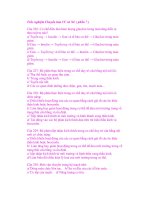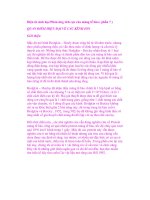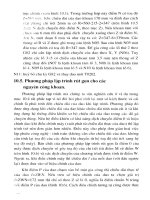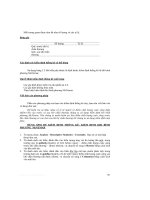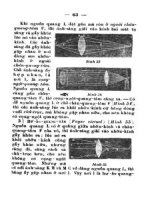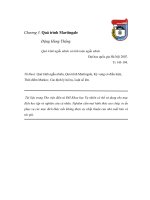Nonlinear Microwave Circuit Design phần 7 ppsx
Bạn đang xem bản rút gọn của tài liệu. Xem và tải ngay bản đầy đủ của tài liệu tại đây (743.75 KB, 40 trang )
228 POWER AMPLIFIERS
[43] P. Colantonio, F. Giannini, G. Leuzzi, E. Limiti, ‘Direct-synthesis design technique for non-
linear microwave circuits’, IEEE Trans. Microwave Theory Tech., MTT-43(12), 2851–2855,
1995.
[44] R.A. Minasian, ‘Intermodulation distortion analysis of MESFET amplifiers using the Volterra
series representation’, IEEE Trans. Microwave Theory Tech., MTT-28(1), 1–8, 1980.
[45] R.S. Tucher, C. Rauscher, ‘Modelling the third-order intermodulation-distortion properties of
GaAs FET’, Electron. Lett., 3, 508–510, 1977.
[46] M.R. Moazzam, C.S. Aitchison, ‘A low third order intermodulation amplifier with harmonic
feedback circuitry’, IEEE MTT-S Int. Microwave Symp. Dig., 1996, pp. 827–830.
[47] P. Colantonio, F. Giannini, G. Leuzzi, E. Limiti, ‘IMD performances of harmonic-tuned
microwave power amplifiers’, Proc. of the European Gallium Arsenide Applications
Symposium, Paris (France), Oct. 2000, pp. 132–135.
[48] P. Colantonio, F. Giannini, G. Leuzzi, E. Limiti, ‘High-efficiency low-IM microwave PA
design’, IEEE MTT-S Int. Microwave Symp. Dig.,Vol.1, Phoenix (AZ), May 2001, pp.
511–514.
[49] A. Betti-Berutto, T. Satoh, C. Khandavalli, F. Giannini, E. Limiti, ‘Power amplifier second
harmonic manipulation: mmWave application and test results’, Proc. of the European Gallium
Arsenide Applications Symposium, Munich (Germany), Oct. 1999, pp. 281–285.
5
Oscillators
5.1 INTRODUCTION
In this introduction, a short description of the oscillatory circuits more commonly used in
microwave circuits is given, and a brief recapitulation of the main methods available for
‘unstable’ circuit design is provided.
Oscillators can, in principle, be considered as linear circuits, since an instability
giving rise to an oscillatory behaviour, for instance sinusoidal, is a linear phenomenon.
In fact, most oscillators are designed by means of linear concepts and tools, and their
performances are satisfactory, at least for basic applications. However, many oscillatory
performances have an intrinsically nonlinear nature, and they are becoming increasingly
important in microwave applications. First, the amplitude of the oscillation cannot be
predicted by linear considerations only, and also the frequency of oscillation is often not
accurately predicted; however, simple empirical considerations can yield a reasonable
estimation of the power being produced by the oscillator, and the use of high-Q resonators
can force the frequency to be very close to the desired value. Nonetheless, a fully nonlinear
method can give a better and more accurate evaluation of the actual performances of the
oscillator, ensuring a first-pass design. Still more important, there are phenomena that can
be described only by means of purely nonlinear considerations. The circuits that exploit
such features are becoming increasingly important in microwave systems: for instance,
injection locking of an oscillator, which is fundamental in an oscillator array; phase-
noise reduction for accurate phase modulation/demodulation; subharmonic generation for
phase-locked loops; chaos prediction for chaotic communication or for chaos avoidance.
In this chapter, the linear conditions for stability and oscillation are first recalled; then,
methods for large-signal behaviour prediction are briefly summarised. The most common
and practical fully nonlinear analysis methods that are becoming increasingly important
for accurate oscillator design are then reviewed. Methods for noise evaluation, mostly of
nonlinear nature in oscillators, are also briefly discussed together with the guidelines for
low phase-noise oscillator design. Stability in nonlinear regime for the design of general
microwave circuits free of spurious oscillations of nonlinear origin or for the design of
intentionally unstable nonlinear circuits, as frequency dividers and chaotic oscillators, and
an overview of frequency locking in microwave oscillators are treated in Chapter 8.
Nonlinear Microwave Circuit Design F. Giannini and G. Leuzzi
2004 John Wiley & Sons, Ltd ISBN: 0-470-84701-8
230 OSCILLATORS
5.2 LINEAR STABILITY AND OSCILLATION CONDITIONS
In this paragraph, the stability or instability of linear circuits are described as a prelimi-
nary step for both nonlinear oscillation design and for nonlinear stability determination.
The behaviour of a linear autonomous network, that is, a network without external
signals, is represented by a homogeneous system of linear equations. The standard case in
electronic circuits, however, involves a nonlinear network including solid-state nonlinear
components (diodes, transistors) biased by one or more power supplies establishing an
operating DC point. The operating or quiescent point is usually found by approximate
graphical methods (load line), by approximate nonlinear analysis making use of simple
models for the nonlinear device(s) or by accurate numerical nonlinear network analysis,
usually by means of a CAD program. Once the quiescent point is determined, the cir-
cuit is linearised and linear parameters are evaluated, as for instance the hybrid model,
the Giacoletto model, or whatever equivalent (see Chapter 3), or by black-box data as
scattering parameters, usually found by direct measurement. As long as any RF signal
establishing itself in the circuit remains small, that is, as long as its amplitude does not
exceed the range for which the linearisation holds, this is accurate enough for the anal-
ysis and design of the RF behaviour of the circuit. In this paragraph, this hypothesis is
assumed to hold and purely linear considerations are made.
The unknowns of the homogeneous (Kirchhoff’s) system of equations are voltages,
currents, waves or a mixture of these, depending on the type of equations selected. In all
cases, a trivial or degenerate solution is always possible when all voltages and currents are
zero. This is the solution at all frequencies when the circuit is stable or at all frequencies
except one or more than one when the circuit oscillates. At each of these frequencies, the
determinant of the system of equations is zero and a non-trivial or non-degenerate solution
exists. This or these solutions represent the oscillation(s) in the circuit. Let us assume a
nodal analysis of the circuit (KCL), and therefore an admittance-matrix representation of
the circuit:
I =
↔
Y ·
V =
0 (5.1)
where
↔
Y is an n ×n complex matrix and
V,
I and
0aren ×1 complex vectors of the
unknown voltages, of the node currents and the zero vector respectively, for a circuit
with n nodes. The admittance matrix
↔
Y is a function of the values of the elements of
the circuit, both linear (passive elements and parasitic elements of the active device) and
linearised (intrinsic elements of the active device); it is also a function of the (angular)
frequency ω. The condition for the existence of an oscillation at a generic frequency ω
0
therefore is the scalar equation:
det(
↔
Y) = 0 (5.2)
The left-hand side of the equation can be seen as a function of the frequency,
which is the unknown of eq. (5.2), for fixed values of the elements of the circuit: this is
the case in which an existing circuit is analysed for determination of its stability:
det(
↔
Y) = F(ω
0
) = 0 (5.3)
LINEAR STABILITY AND OSCILLATION CONDITIONS 231
If the equation has no solution for any frequency ω, then the circuit is stable;
otherwise, if one or more solutions exist, the circuit will oscillate at all the frequencies
solution of the equation. Nothing can be said on the amplitudes of the oscillations or on
the existence of other spurious frequencies generated by their interactions.
Otherwise, the left-hand side of eq. (5.2) can be a function of the value(s) of one
or more circuit elements, while the frequency has a fixed value ω
0
:
det(
↔
Y) = G(R,L,C, )= 0 (5.4)
The set of values of the circuit elements that satisfy the equation, if any exists,
is the solution to the problem of the design of an oscillator at a given frequency ω
0
.In
order for the solution to be satisfactory from a practical point of view, it must be verified
that eq. (5.3) with the designed values of the circuit elements has no solution for any
other frequency ω.
This is complete from a mathematical point of view, but is not practical from the
designer’s point of view. Therefore, simpler approaches are developed. First of all, the
network can be divided into two subnetworks at an arbitrary port (Figure 5.1). The two
subnetworks are represented in a nodal approach by two scalar complex admittances.
Systems (5.1) and (5.2) become scalar equations:
I
L
+ I
R
= (Y
L
+ Y
R
) · V = 0 (5.5)
Y
L
+ Y
R
= 0 (5.6)
Equation (5.6) is also known as the Kurokawa oscillation condition [1]. It can
be shown (e.g. [2–4]) that if eq. (5.6) is satisfied, the whole network oscillates, unless
there are unconnected parts of the network. A simple illustration is given here for a
cascaded network with two nodes; the two-port network in the middle typically stands
for a biased active device (a transistor), while the two one-port networks are the input-
and output-matching networks. For the circuit shown in Figure 5.2, eq. (5.1) reads as
Y
11
Y
12
Y
21
Y
22
+
Y
source
0
0 Y
load
·
V
1
V
2
=
0
0
(5.7)
and eq. (5.2) reads as
(Y
11
+ Y
source
) · (Y
22
+ Y
load
) − Y
12
Y
21
= 0 (5.8)
I
L
Y
L
I
R
Y
R
V
+
−
Figure 5.1 A port connecting the two subnetworks of an autonomous linear circuit
232 OSCILLATORS
V
1
V
2
Y
2p
Y
load
Y
source
Figure 5.2 A cascaded two-node network
Equation (5.8) can be rearranged in two different ways:
Y
source
=−Y
11
+
Y
12
Y
21
Y
22
− Y
load
=−Y
in
(5.9)
Y
load
=−Y
22
+
Y
12
Y
21
Y
11
− Y
source
=−Y
out
(5.10)
Equations (5.9) and (5.10) correspond to the arrangements shown in Figure 5.3.
Equations (5.9) and (5.10) are equivalent, showing that the oscillation condition
can be imposed equivalently at the input or at the output port of the active two-port
network; we remark that no assumption has been made on the networks.
Let us now come back to eq. (5.6): this complex equation can be split into two
real ones:
Y
r
L
+ Y
r
R
= 0 (5.11a)
Y
j
L
+ Y
j
R
= 0 (5.11b)
Y
source
Y
in
Y
load
V
1
V
2
Y
2p
Y
source
Y
out
Y
load
V
1
V
2
Y
2p
(a)
(b)
Figure 5.3 The two-node cascaded network reduced to a one-node network in two different ways
LINEAR STABILITY AND OSCILLATION CONDITIONS 233
where Y
r
and Y
j
are the real and imaginary parts respectively of the complex admittance
parameter Y = Y
r
+ jY
j
. System (5.11) can be interpreted in the following way: one of
the two subnetworks must exhibit a negative conductance, whose absolute value must
equal the positive conductance of the other subnetwork; moreover, the two susceptances
must resonate. In practice, the subnetwork including the active device provides the neg-
ative conductance, while the other subnetwork must be designed in order that eq. (5.11)
be satisfied.
Equivalently, if Kirchhoff’s voltage law impedance parameters are used, the circuit
can be represented as in Figure 5.4, and eqs. (5.2) and (5.11) become
det(
↔
Z) = 0 (5.12)
Z
r
L
+ Z
r
R
= 0 (5.13a)
Z
j
L
+ Z
j
R
= 0 (5.13b)
Similar considerations as above can be repeated by replacing conductance and
susceptance with resistance and reactance respectively.
In microwave circuits, waves and scattering parameters are normally used instead
of voltages, currents and impedance parameters. Equivalently, the network shown in
Figure 5.3 is modified to the network as shown in Figure 5.5, and eqs. (5.1), (5.2), (5.9),
(5.10) and (5.11) become
b =
↔
·a =a (5.14)
det(
↔
−
↔
1) = 0 (5.15)
source
=
S
11
+
S
12
S
21
1 − S
22
load
−1
=
1
in
(5.16)
load
=
S
22
+
S
12
S
21
1 − S
11
source
−1
=
1
out
(5.17)
Z
L
I
Z
R
V
L
+
−
V
R
+
−
Figure 5.4 A series connection of the two subnetworks of an autonomous linear circuit
234 OSCILLATORS
Γ
source
Γ
in
Γ
out
Γ
load
S
2p
Γ
source
Γ
load
S
2p
(a)
(b)
Figure 5.5 The two-node cascaded network reduced to a one-node network, using scattering
parameters
|
L
|·|
R
|=1 (5.18a)
L
+
R
= 0 (5.18b)
System (5.18) is equivalent to what is commonly known as the Barkhausen oscil-
lation condition. Equation (5.18a) implies that the wave reflected by one of the two
subnetworks (the one including the active device, e.g. the right one) must have an ampli-
tude greater than that of the incident wave
|
R
| > 1 (5.19)
while the other subnetwork must attenuate the incident wave so that gain and loss of the
two subnetworks compensate:
|
L
|=
1
|
R
|
(5.20)
Equation (5.18b) states that phase delays of the two subnetworks must compensate,
yielding zero total phase delay.
This approach is well known and very simple; however, this is not the situation
the designer actually has to look for. Typically, an oscillator must be designed in such a
LINEAR STABILITY AND OSCILLATION CONDITIONS 235
way that a growing instability is present in the circuit, so that the noise always present
in the circuit can increase to a fairly large amplitude at the oscillation frequency only.
Therefore, all signals have a time dependence of the form
v(t) = v
0
· e
(α+jω)t
or a(t) = a
0
· e
(α+jω)t
(5.21)
Admittance, impedance or scattering parameters in eqs. (5.2), (5.3) and (5.14) res-
pectively must be computed as functions of the complex Laplace parameter s = α +jω
instead of the standard (angular) frequency ω. In the analysis case, eq. (5.3) and its
equivalent condition for an impedance or wave representation are
F
Y
(α
0
+ jω
0
) = 0 (5.22a)
F
Z
(α
0
+ jω
0
) = 0 (5.22b)
F
(α
0
+ jω
0
) = 0 (5.22c)
The circuit is an oscillator if one or more solutions exist for one or more values
of ω
0
with also α
0
> 0. Conversely, an oscillator must be designed from eq. (5.4), or its
equivalent condition for an impedance or wave representation, so that
G
Y
(R,L,C, ) = 0 (5.23a)
G
Z
(R,L,C, ) = 0 (5.23b)
G
(R,L,C, ) = 0 (5.23c)
are satisfied for the desired value of the Laplace parameter ω = ω
0
and α = α
0
> 0.
A practical problem when using eq. (5.22) or eq. (5.23) instead of eq. (5.3) and
eq. (5.4) arises from the fact that CAD programs do not usually compute network param-
eters in the Laplace domain. Equivalent conditions must therefore be available requiring
only standard frequency-domain expressions. Typically, an oscillator includes a resonator
that forces the circuit to oscillate near its resonant frequency, more or less independently of
the amplitude of voltages and currents in the circuits. Therefore, eq. (5.11b) or eq. (5.18b)
mainly involving the frequency-dependent elements can typically be computed in the fre-
quency domain, that is with α = 0, to a good degree of approximation. Contrariwise,
eq. (5.11a) or eq. (5.18a) mainly involving the negative- and positive-resistance terms
typically are sensitive to voltage and current amplitudes in the circuit. From what has
been said above, it seems to be a reasonable assumption that the circuit be designed in
such a way that the total conductance or resistance be negative or that the total reflection
be greater than one:
Y
r
L
+ Y
r
R
< 0 (5.24a)
Z
r
L
+ Z
r
R
< 0 (5.24b)
|
L
|·|
R
| > 1 (5.24c)
While conditions (5.24a) and (5.24b) are correct, condition (5.24c) is not generally
true; a simple example is sufficient to clarify the point. Let us consider a simple parallel
resonant circuit as in Figure 5.6.
236 OSCILLATORS
G
s
C
s
L
s
Γ
s
Γ
d
G
d
Figure 5.6 A parallel resonant circuit
Kirchhoff’s current law at the only node, written in the form of eq. (5.22a), is
G
s
+ G
d
+ sC +
1
sL
= 0 (5.25)
whence
s
0
=−
G
tot
2C
±
G
tot
2C
2
−
1
LC
(5.26)
where
G
tot
= G
s
+ G
d
(5.27)
For a growing oscillation, we must have
α
0
> 0 ⇒ G
tot
= G
s
+ G
d
< 0 (5.28)
If the left subcircuit is a biased active device behaving as a negative conductance
and the right subcircuit is a passive network, so that
G
s
< 0 G
d
> 0 (5.29)
we must have
|G
s
| >G
d
or −G
s
>G
d
(5.30)
This condition gives a growing instability, thus confirming the validity of eq. (5.24a).
In particular, if the quality factor (Q) of the circuit is high, that is, if
G
tot
2
C
L
(5.31)
the complex Laplace parameter can be approximated by
s
0
= α
0
± jω
0
∼
=
−
G
tot
2C
± j
1
√
LC
(5.32)
LINEAR STABILITY AND OSCILLATION CONDITIONS 237
and the oscillation frequency is
ω
0
=
1
√
LC
(5.33)
independent of the resistive elements in the circuit.
Let us now check whether eq. (5.24c) is also valid. If condition (5.31) holds,
the reflection coefficients of the left and right subcircuits in Figure 5.6 can be approxi-
mated by
s
∼
=
G
0
− G
s
G
0
+ G
s
d
∼
=
G
0
− G
d
G
0
+ G
d
(5.34)
where G
0
=
1
Z
0
= 20 mS. It is by no means true that if eq. (5.30) holds, then eq. (5.24c)
is satisfied. Let us show this by assigning actual values to the resistive elements of the
circuit. For instance, we can take
G
s
=−30 mS G
d
= 25 mS (5.35)
which gives growing instability since eq. (5.30) is satisfied. For the reflection coefficients,
we have
s
=−5
d
=
1
9
|
s
|·|
d
|=
5
9
< 1 (5.36)
and eq. (5.24c) is not satisfied. If we take
G
s
=−15 mS G
d
= 10 mS (5.37)
eq. (5.30) is again satisfied, and the circuit is unstable. For the reflection coefficients,
we have
s
= 7
d
=
1
3
|
s
|·|
d
|=
7
3
> 1 (5.38)
Equation (5.24c) is now satisfied. It is therefore clear that eq. (5.22b) is not correct.
The above considerations can be repeated for a series resonant circuit as in
Figure 5.7. We get
s
0
=−
R
tot
2L
±
R
tot
2L
2
−
1
LC
(5.39)
where
R
tot
= R
s
+ R
d
(5.40)
For a growing oscillation, we must have
α
0
> 0 ⇒ R
tot
= R
s
+ R
d
< 0 (5.41)
If
R
s
< 0 R
d
> 0 (5.42)
238 OSCILLATORS
R
s
L
s
Γ
s
Γ
d
R
d
C
s
Figure 5.7 A series resonant circuit
we must have
|R
s
| >R
d
or −R
s
>R
d
(5.43)
This condition gives a growing instability. In particular, if the Q of the circuit is
high, that is, if
R
tot
2
L
C
(5.44)
the complex Laplace parameter can be approximated by
s
0
= α
0
± jω
0
∼
=
−
R
tot
2L
± j
1
√
LC
(5.45)
and the oscillation frequency is again
ω
0
=
1
√
LC
(5.46)
independent of the resistive elements in the circuit. Equation (5.34) becomes
s
∼
=
R
s
− R
0
R
s
+ R
0
d
∼
=
R
d
− R
0
R
d
+ R
0
(5.47)
It can be shown that the origin of the ambiguity in the instability criterion for
the amplitudes of the reflection coefficients (5.24c) lies in the range of values that the
circuit conductances or resistances assume with respect to the normalising conductance or
resistance respectively. A practical arrangement for working with reflection coefficients
in the frequency domain with a design criterion similar to eq. (5.24a) or eq. (5.24b) is the
following. The instability criterion is computed at the port where the external resistive
load is connected to the oscillator (Figure 5.8).
LINEAR STABILITY AND OSCILLATION CONDITIONS 239
Oscillator
Z
L
=
Z
0
Γ
osc
Γ
load
Figure 5.8 An oscillator partitioned at the output port
In this case, no ambiguity is present. Since the load is real, for stable oscillations
the phase of
osc
must be zero and its amplitude must be infinite so that
osc
·
load
= 1 (5.48)
This situation corresponds to Z
osc
=−Z
0
=−50 . For growing instability, the
oscillator can be approximated as a series or parallel resonator in the vicinity of the
resonant frequency ω
0
where
osc
(ω
0
) = 0. In the case that the resonance is a series
one, then
R
osc
(ω
0
)<−50 ⇒ 1 <
osc
(ω
0
)<∞ (5.49)
If the resonance is a parallel one, then from eq. (5.34),
G
osc
(ω
0
)<−20 mS ⇒−∞<
osc
(ω
0
)<−1 (5.50)
The type of resonance is easily evaluated on the Smith Chart if the reflection
coefficient is plotted as a function of frequency around ω
0
: in a parallel resonance, the
impedance or admittance of the oscillator changes from inductive below ω
0
to capacitive
above ω
0
; the reverse is true for a series resonance. Therefore, four situations are possible:
two stable ones and two unstable ones giving rise to a growing oscillation. They are
depicted in Figure 5.9 for the sake of illustration.
A more rigorous and general formulation is as follows [5, 6]. Let us come back to
the general equation system in eq. (5.1); its determinant in the Laplace domain has been
introduced in eq. (5.22). For typical oscillators, a solution s
0
= α
0
+ jω
0
of eq. (5.22) in
the complex Laplace plane is located in the vicinity of the frequency ω
1
where the phase
of the function F(jω) becomes zero (Figures 5.10, 5.11 and 5.12); from an electrical
point of view, this corresponds to resonating the circuit reactances computed in periodic
regime s = jω.
We can therefore write the solution of eq. (5.22) as
s
0
= α
0
+ jω
0
= α
0
+ j(ω
1
+ δω) (5.51)
where both α
0
and δω are small compared to ω
1
. Expanding in Taylor series F(s + jω)
around s = jω
1
we get (see Appendix A.10)
F(s +jω)
∼
=
F(jω
1
) −
∂F(jω)
∂ω
ω=ω
1
(∂ω −jα
0
) +···=0 (5.52)
240 OSCILLATORS
Figure 5.9 The four resonance types of an oscillator at its output port: parallel unstable, parallel
stable, series unstable and series stable
Equation (5.52) is solved for α
0
, yielding
α
0
=−F(jω
1
) ·
Im
∂F(jω)
∂ω
ω=ω
1
∂F(jω)
∂ω
ω=ω
1
2
(5.53)
Four cases are possible, depending on the sign of F(jω
1
) and Im
∂F(jω)
∂ω
ω=ω
1
;
are listed in Table 5.1.
LINEAR STABILITY AND OSCILLATION CONDITIONS 241
s
0
= a
0
+
j
w
0
a
0
a
j
w
1
j
w
dw
Figure 5.10 The zero of the function F(s) = F(α + jω) in the complex Laplace plane
w
1
w
w
1
w
Im[
F
(
j
w)]
Re[
F
(
j
w)]
Figure 5.11 A qualitative behaviour of the complex function F(s) = F(α + jω) along the imag-
inary axis of the complex Laplace plane
242 OSCILLATORS
w
0
w
1
w
0
w
1
∂w
w
w
Im[
F
(a
0
+
j
w)]
Re[
F
(a
0
+
j
w)]
Figure 5.12 A qualitative behaviour of the complex function F(s) = F(α+ jω) along the α = α
0
line of the complex Laplace plane
Table 5.1 Stability test for an oscillator
F(jω
1
) Im
∂F(jω)
∂ω
ω=ω
1
Stability
Positive Positive Stable
Positive Negative Unstable
Negative Negative Stable
Negative Positive Unstable
From an electrical point of view, the four cases correspond to the series and parallel
resonances described above.
Let us illustrate this result with our example parallel resonant oscillating circuit
in Figure 5.6. The determinant of Kirchhoff’s equation system in our case becomes
(eq. (5.25)):
F(s) = G
s
+ G
d
+ sC +
1
sL
= G
tot
+ sC +
1
sL
= 0 (5.54)
The determinant computed for s = jω is
F(jω) = G
tot
+ jωC +
1
jωL
= G
tot
+ j
ωC −
1
ωL
(5.55)
FROM LINEAR TO NONLINEAR 243
Its imaginary part becomes zero for
ω
1
=
1
√
LC
(5.56)
From the above,
∂F
∂ω
=−
2αω
(α
2
− ω
2
)
2
+ 4α
2
ω
2
·
1
L
+ j
C −
α
2
− ω
2
(α
2
− ω
2
)
2
+ 4α
2
ω
2
·
1
L
(5.57)
∂F
∂ω
s=jω
1
= j
C +
1
ω
2
1
·
1
L
= j2C (5.58)
Therefore,
α
0
=−
G
tot
2C
(5.59)
Referring to Table 5.1, we have
Im
∂F(jω)
∂ω
ω=ω
1
= 2C>0 (5.60)
always; therefore, if G
tot
> 0, then F(jω
1
)>0, and the circuit is stable. Otherwise, when
G
tot
< 0, then F(jω
1
)<0, and the circuit is unstable, as found earlier. The real part of
the Laplace constant is also evaluated from eq. (5.53), with the same result as above.
5.3 FROM LINEAR TO NONLINEAR: QUASI-LARGE-SIGNAL
OSCILLATION AND STABILITY CONDITIONS
In this paragraph, the linear stability and oscillation conditions so far described are
modified to take into account the nonlinearity, that is, the dependence of the oscillator
parameters on the amplitude of the signal.
The stability and oscillation conditions given so far are valid only in linear regime.
However, the behaviour of actual oscillating circuits always involves the nonlinear char-
acteristics of the active device. A rigorous study requires the use of full-nonlinear analysis
methods that will be described in Section 5.4. However, many conclusions of the previ-
ous paragraph are extended to the nonlinear regime by means of simple considerations
requiring a general knowledge of the dependence of circuit parameters on the amplitude
of the signal.
First of all, let us extend the stability and oscillation considerations described in
the previous paragraph to a circuit with parameters varying with the amplitude of the
signal. Let us first consider the reflection coefficients (e.g. those shown in Figure 5.5)
dependent on the amplitude of the signal within the oscillator. Intuition and experi-
ence suggest that a growing instability will not grow forever but will saturate at a
certain amplitude, because of the limitations of the active device. Therefore, let us
244 OSCILLATORS
assume that the steady-state periodic regime has been attained when the signal within
the oscillator has reached the equilibrium amplitude A
0
with oscillation frequency ω
0
.
Equations (5.11), (5.13) and (5.18) are now rewritten, in complex form, and explicitly
indicate the network parameter dependence on signal amplitude:
Y
s
+ Y
d
= Y
tot
(A
0
,ω
0
) = 0 (5.61a)
Z
s
+ Z
d
= Z
tot
(A
0
,ω
0
) = 0 (5.61b)
s
·
d
=
tot
(A
0
,ω
0
) = 1 (5.61c)
We remark that a feedback oscillator can be studied in the same way as a negative-
resistance oscillator by writing
A · β = T(A
0
,ω
0
) = 1 (5.62)
It is now interesting to derive a formal stability criterion [1, 4, 7]. Let us apply
a small perturbation δA to the amplitude of the oscillating signal; if the oscillation is
stable, the amplitude will come back to the same value as it was before the perturbation.
Since the perturbation is small, the perturbed admittance in eq. (5.61a) can be expanded
in Taylor series to the first order, and eq. (5.61a) becomes
Y
tot
(A
0
,jω
0
) +
∂Y
tot
(A, s)
∂A
A = A
0
s = jω
0
· δA +
∂Y
tot
(A, s)
∂s
A = A
0
s = jω
0
· δs +···=0 (5.63)
where s
0
= jω
0
and δs = δα + jδω. The perturbed complex Laplace parameter becomes
s
0
= s
0
+ δs = δα + j(ω
0
+ δω) (5.64)
Since Y
tot
(A
0
,ω
0
) = 0, we have
∂Y
tot
(A, s)
∂A
A = A
0
s = jω
0
· δA +
∂Y
tot
(A, s)
∂s
A = A
0
s = jω
0
· δs
∼
=
0 (5.65)
If the real part of the perturbed Laplace parameter is negative, the amplitude of
the perturbation will decrease to zero and the oscillation will come back to the previous
state. Equation (5.65) becomes
∂Y
tot
(A, s)
∂A
A = A
0
s = jω
0
· δA −j
∂Y
tot
(A, s)
∂ω
A = A
0
s = jω
0
· δs
∼
=
0 (5.66)
whence
δs = δα + jδω
∼
=
−j
∂Y
tot
∂A
∂Y
tot
∂ω
· δA =−j
∂Y
tot
∂A
·
∂Y
∗
tot
∂ω
∂Y
tot
∂ω
2
· δA (5.67)
FROM LINEAR TO NONLINEAR 245
where the partial derivatives are computed in the unperturbed oscillation state, that is for
s = jω
0
, and the star denotes complex conjugation. By dividing eq. (5.67) into real and
imaginary parts we get
δα
∼
=
∂Y
r
∂ω
∂Y
i
∂A
−
∂Y
r
∂A
∂Y
i
∂ω
∂Y
tot
∂ω
2
· δA (5.68a)
δω
∼
=
−
∂Y
r
∂A
∂Y
r
∂ω
+
∂Y
i
∂A
∂Y
i
∂ω
∂Y
tot
∂ω
2
· δA (5.68b)
where
∂Y
tot
∂ω
=
∂Y
r
∂ω
+ j
∂Y
i
∂ω
∂Y
tot
∂s
=
∂Y
r
∂s
+ j
∂Y
i
∂s
(5.69)
Therefore, the stability condition is
δα < 0 ⇒
∂Y
r
∂A
∂Y
i
∂ω
−
∂Y
r
∂ω
∂Y
i
∂A
> 0 (5.70)
If eq. (5.70) is satisfied, the oscillation is stable. Similarly,
∂Y
r
∂A
∂Y
r
∂ω
+
∂Y
i
∂A
∂Y
i
∂ω
= 0 ⇒ δω = 0 (5.71)
If the eq. (5.71) is satisfied, the frequency of oscillation is stable and will not change for
a small perturbation of the amplitude of the oscillating signal. The smaller the expression
at the left-hand side of the first of eq. (5.71), the smaller the sensitivity of the oscillation
frequency to an amplitude perturbation.
Equations (5.70) and (5.71) can be equivalently rewritten in terms of the impedance
and reflection coefficient representation of the network, with equivalent results.
We can also rewrite eq. (5.70) in the following form:
0
◦
< Arg
∂T
∂ω
A = A
0
s = jω
0
− Arg
∂T
∂A
A = A
0
s = jω
0
< 180
◦
(5.72)
where the function T is any of the network functions in eq. (5.61) or eq. (5.62). Geo-
metrically, eq. (5.72) can be interpreted as follows: the oscillatory state is stable if the
angle between the derivative of the function T(A,ω) with respect to frequency and the
derivative with respect to amplitude is greater that 0
◦
and less than 180
◦
in the complex
plane of the function T(A,ω), when taken counterclockwise.
246 OSCILLATORS
G
s
(
A
)
jB
s
(
A
)
G
d
(w)
jB
d
(w)
Active device Passive embedding network
Figure 5.13 A parallel resonant circuit partitioned into an active and a passive subcircuit
Let us illustrate the rule for a parallel resonant circuit, as partitioned in Figure 5.1,
and repeated in Figure 5.13, where one subcircuit includes the nonlinear amplitude-
dependent active device and the other the linear amplitude-independent passive embedding
network. We can assume that the reactive part of the active device is frequency-
independent when the embedding network has a very strong frequency dependence, so
that the former can be neglected in the narrowband near the resonant frequency; this is
usually the case for single-frequency oscillators that include a high-Q resonator in the
passive network for frequency stabilisation.
The admittances are
Y
s
(A) = G
s
(A) + jB
s
(A) Y
d
(ω) = G
d
(ω) +jB
d
(ω) Y
tot
(A, ω) = Y
s
(A) + Y
d
(A)
(5.73)
The oscillation condition requires that
Y
tot
(A
0
,ω
0
) = Y
s
(A
0
) + Y
d
(ω
0
) = 0 (5.74)
In real and imaginary parts,
G
tot
(A
0
,ω
0
) = G
s
(A
0
) + G
d
(ω
0
) = 0 B
tot
(A
0
,ω
0
) = B
s
(A
0
) + B
d
(ω
0
) = 0 (5.75)
This formula can be represented graphically on the complex plane of the admittance
(Figure 5.14). Two curves are traced on the plane, the former being the admittance locus
of the device as a function of the amplitude of the signal and the latter being the negated
admittance locus of the embedding network as a function of the frequency [1].
Equation (5.75) tells us that the amplitude and frequency of the oscillation are
found at the intersection of the two curves. The stability condition of eq. (5.70) now
reads as
∂G
s
∂A
∂B
d
∂ω
−
∂G
d
∂ω
∂B
s
∂A
> 0 (5.76)
FROM LINEAR TO NONLINEAR 247
jB
A
=
A
0
w = w
0
G
Y
d
(w)
∂
Y
d
(w)
∂w
Y
s
(
A
)
ω
a
A
∂
Y
s
(
A
)
∂
A
Figure 5.14 Loci of the device and embedding network admittances
and it can be interpreted graphically that the angle α between the vector of the derivative
of the two curves with respect to the curve variable have a value between 0
◦
and 180
◦
,
with maximum stability when α = 90
◦
.
The same considerations can be repeated if the two subnetworks are represented
by impedance parameters or reflection coefficients, leading to similar results. The results
for the impedance parameter representation are easily deduced by the use of duality. For
the reflection coefficient, the oscillation condition reads
d
(ω
0
) =
1
s
(A
0
)
(5.77)
For the derivation of the stability condition, we can remark that the reflection coef-
ficient is related to admittance and impedance parameters by conformal transformations;
therefore, angles are preserved, and so the requirement that (Figure 5.15)
0
◦
<β<180
◦
and β = 90
◦
for maximum stability.
This can be obtained by analytical calculations also [8]. We first write the reflection
coefficients as
s
(A) = ρ ·e
jϑ
d
(ω) = η ·e
jξ
(5.78)
The stability condition eq. (5.70) reads as
η ·
dρ
dA
·
dξ
dω
− ρ ·
dϑ
dA
·
dη
dω
> 0 (5.79)
248 OSCILLATORS
dΓ
d
/dω
dΓ
s
/d
A
Γ
d
(w)
b
Γ
s
(
A
)
10.0
10.0
5.0
4.0
3.0
2.0
1.0
0.8
0.6
0.4
0.2
−10.0
−5.0
−4.0
−3.0
−2.0
−1.0
−0.8
−0.6
−0.4
−0.2
5.0
4.0
3.0
2.0
1.0
0.8
0.6
0.4
0.2
0
Figure 5.15 Loci of the device and embedding network reflection coefficients for stability crite-
rion definition
If we define
1
s
(A)
= ζ · e
jψ
=
1
ρ
· e
−jϑ
(5.80)
the stability condition becomes
dζ
dA
·
dξ
dω
−
dη
dω
·
dψ
dA
< 0 (5.81)
Let us illustrate again the rule with the oscillator as partitioned in Figure 5.8.
In small-signal linear regime, the circuit has already been shown to present a growing
instability when the reflection coefficient of the oscillator at the output port
osc
has a
parallel resonance for ω = ω
0
with −∞ <
osc
< −1 (Figure 5.9a). This corresponds to
a small-signal negative conductance:
G
osc,ss
> −20 mS (5.82)
As the signal grows in amplitude, the negative conductance provided by the oscil-
lator increases (algebraically) as the power amplifying capability of the active device
tends to saturate. A qualitative behaviour of the output conductance of the oscillator as a
function of the signal amplitude is shown in Figure 5.16.
Correspondingly, the curve traced by the reflection coefficient of the oscillator at
the output port as a function of frequency shifts outwards from the centre of the Smith
FROM LINEAR TO NONLINEAR 249
A
A
0
G
osc
G
osc,ss
−
G
0
= −20 ms
Figure 5.16 Qualitative behaviour of the output negative conductance of the oscillator as a func-
tion of the amplitude of the oscillating signal
w > ω
0
w > w
0
dρ
d
A
δρ
δw
−0.5
−0.5
−0.5
0.5
0
1.0
−1.0
−2.0
0.5
−0.2
0.2
−1.0
−2.0
2.0
1.0
180 > θ
Figure 5.17 The reflection coefficient of the oscillator at the output port for increasing sig-
nal amplitude
Chart (Figure 5.17). When the conductance reaches the value G
osc
=−20 mS, the curve
passes through the point =−∞and oscillation becomes stable with an amplitude A
0
.
If the reactances of the circuit are approximately independent of the signal amplitude,
that is, if the (passive) resonator has a high quality factor, then the frequency for which
osc
=−∞is still approximately ω
0
, as in small-signal conditions. As can be seen in
Figure 5.17, the angle between the derivative of the reflection coefficient with respect to
amplitude and that taken with respect to frequency is not far from 90
◦
; this ensures a
250 OSCILLATORS
growing instability all along the path from small signal to steady-state oscillation, and
satisfies the stability condition for oscillation once the steady state has been reached.
Let us illustrate the rule with the simple parallel resonant circuit in Figure 5.6,
and study it in the time domain [1, 9]; let us also assume that only the total conductance
depends on the amplitude of the voltage, while the capacitance and inductance are con-
stant. This is approximately true for a circuit where the negative resistance is provided
by an active device: in fact, the reactances in the active device are amplitude dependent;
however, if the LC resonator has a high (loaded) quality factor, then the assumption is
reasonably accurate. Kirchhoff’s equation in the time domain reads as
C ·
dv(t)
dt
+ G
tot
(A) · v(t) +
1
L
·
v(t) · dt = 0 (5.83)
The oscillator will reach equilibrium when the amplitude is such that
G
tot
(A
0
) = 0 (5.84)
Let us assume that the nonlinearities are not too stiff and that the oscillating voltage
at equilibrium is almost sinusoidal:
v(t)
∼
=
A
0
· cos(ω
0
t +ϕ
0
)ω
0
=
1
√
LC
(5.85)
Let us now perturb both amplitude and phase of the oscillating signal
v(t) = (A
0
+ δA(t)) · cos(ω
0
t +(ϕ
0
+ δϕ(t))) (5.86)
and see which is the evolution in time of the small perturbations. The derivative and
integral with respect to time of the perturbed voltage, approximated to the first order in
the perturbations, are
dv(t)
dt
=
dA(t)
dt
A=A
0
· cos(ω
0
t +ϕ
0
) −A
0
·
ω
0
+
dϕ
dt
ϕ=ϕ
0
· sin(ω
0
t +ϕ
0
) (5.87)
v(t) · dt =
1
ω
2
0
·
dA(t)
dt
A=A
0
· cos(ω
0
t +ϕ
0
) +
A
0
ω
0
· sin(ω
0
t +ϕ
0
) −
A
0
ω
2
0
·
dϕ
dt
ϕ=ϕ
0
· sin(ω
0
t +ϕ
0
) (5.88)
We also have
G
tot
(A
0
+ δA(t))
∼
=
G
tot
(A
0
) +
dG
tot
dA
A=A
0
· δA(t) =
dG
tot
dA
A=A
0
· δA(t) (5.89)
By replacing in eq. (5.87) and eq. (5.88), and separating the terms with sinus and
cosinus time dependence, we get
C +
1
ω
2
0
L
·
d(δA)
dt
+
dG
tot
dA
· δA = 0 (5.90)
FROM LINEAR TO NONLINEAR 251
−ω
0
C +
1
ω
0
L
−
C +
1
ω
2
0
L
·
dϕ
dt
= 0 (5.91)
Since we are considering the oscillation at equilibrium, eq. (5.85) holds, and we get
2C ·
d(δA)
dt
+
dG
tot
dA
· δA = 0 (5.92)
2C ·
dϕ
dt
= 0 (5.93)
From eq. (5.92),
δA(t) = δA(t
0
) · e
−
dG
tot
dA
·
t
2C
(5.94)
The perturbation will vanish exponentially with time, and the amplitude of the oscillation
will come back to the equilibrium value if
dG
tot
(A)
dA
A=A
0
> 0 (5.95)
The oscillation will therefore be stable. The amplitude-dependent total conductance
usually results from the sum of an amplitude-independent passive positive conductance
(the load) and an amplitude-dependent active negative conductance (the biased active
device). Typical conductances are as in Figure 5.16. Therefore, the total conductance
has a positive derivative with respect to the amplitude of the oscillating signal, and the
oscillation is stable. Otherwise, if the negative resistance becomes more negative as the
signal grows, the oscillation is not stable and a small perturbation will grow exponentially
in time until a stable equilibrium point is reached. An example is shown below for an
amplifier with gain expansion.
From eq. (5.93), we see that a perturbation of the phase will not grow or vanish
in time. This is natural in a time-invariant autonomous circuit: the time origin of the
oscillation has no physical meaning, and the circuit will not react to a shift in time of the
oscillating signal.
The result is a particular case of what has been found above. In particular, eq. (5.70)
becomes
∂Y
r
∂A
=
dG
tot
dA
∂Y
i
∂ω
= C>0
∂Y
r
∂ω
=
dG
tot
dω
∼
=
0
∂Y
i
∂A
=
d
dA
ωC −
1
ωL
∼
=
0 (5.96)
∂Y
r
∂A
∂Y
i
∂ω
−
∂Y
r
∂ω
∂Y
i
∂A
∼
=
C ·
dG
tot
dA
> 0 (5.97)
The oscillation is stable. Equation (5.71) becomes
∂Y
r
∂A
=
dG
tot
dA
> 0
∂Y
r
∂ω
=
dG
tot
dω
∼
=
0 (5.98)
252 OSCILLATORS
∂Y
i
∂A
∼
=
0
∂Y
i
∂ω
=
d
dω
ωC −
1
ωL
= C +
1
ω
2
L
= 2C>0 (5.99)
∂Y
r
∂A
∂Y
r
∂ω
+
∂Y
i
∂A
∂Y
i
∂ω
= 0 ⇒ δω = 0 (5.100)
The amplitude and the frequency of the oscillation are stable for small perturbations
of the amplitude of the signal. Let us now plot the admittance on the Smith Chart:
Y
i
(ω) = ωC −
1
ωL
Y
r
(A) =−G
s
(A) + G
0
(5.101)
We get the situation illustrated in Figure 5.17.
5.4 DESIGN METHODS
In this paragraph, design methods making use of simple small- and large-signal concepts
are described for the design of oscillators. Guidelines for high-efficiency design are given,
based on the above considerations.
So far, oscillation and stability conditions have been defined for a designer to
correctly judge whether the circuit will oscillate or not. Now, general guidelines for the
design of oscillating circuits are described. With this goal, let us define some typical
oscillator topologies.
A typical linear design strategy for microwave oscillators [3] is based on a poten-
tially unstable active device at the design frequency of oscillation. In case the device
is stable at that frequency, or if it is desirable to enhance its potential instability at the
design frequency while stabilising it at all other frequencies, a shunt or series-feedback
network (Z
f
) is added. Then, the load at the input of the active device (Z
s
) is chosen
so that a negative resistance is seen at the output of the device at the design frequency
(
do
, with |
do
| > 1); if the input stability circle for the active device including the feed-
back network is drawn,
s
must lie in the unstable part of the Smith Chart. Finally, the
external load is connected to the output of the active device (through Z
d
) in such a way
that the oscillation condition described in the previous paragraph is satisfied at the load
port. Typically, the three networks Z
f
,Z
s
and Z
d
are reactive; Z
f
or Z
s
usually include
a high-Q resonator for frequency stability and low phase noise or a voltage-controlled
reactance for frequency control (VCO). Schematic topologies for both shunt and series
cases are shown in Figure 5.18 for a common-source FET device.
This approach reduces the stability analysis of the oscillator to that of a negative-
resistance one-port network connected to an external 50 load. However, this is not
necessarily the best approach for high-efficiency or low-noise design. Let us rearrange
the circuits in Figure 5.18 as in Figure 5.19, where the external load Z
0
has been included
in the impedance Z
l
, that therefore is no more purely reactive.
More generally, the resistive load can be included in any of the three elements
of the feedback network that assumes a configuration for the shunt feedback and a T
configuration for the series feedback [5, 7, 10, 11]. For these basic configurations, the
